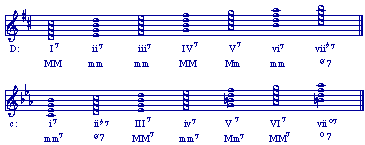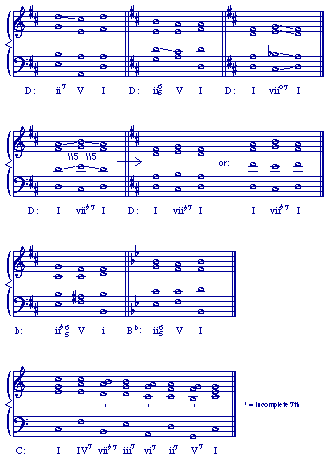
Note that there are no accidentals (chromatic notes) at all except for V7 and viio7 in minor (and also the borrowed chord viio7 in major). All inversions are possible, however, not all of these chords are used with equal frequency. Here's a chart which shows the most-used to least-used:
most used V7 ii7 viio7 IV7 vi7 I7 iii7 least used
(the same order is also the case for minor)
Doubling: use complete 7th chords whenever possible.
Voice Leading: The most important thing to remember is that the 7th resolves down by step (see examples later in this handout).
All of these diatonic 7th chords are used in the same place that you'd use the diatonic triads -- T S D T -- and all that goes with it still applies.
ii7, and especially ii65, is easily the most-used diatonic 7th (except for the V7). Typically, it resolves to V (or I64 then V). Another frequently-used progression:I ii42 V65 I.
viio7 (and viiø7) generally resolve directly to I (i), though they sometimes resolve like this: viio7 V65 I.
IV7 generally resolves to V, and often passes through ii65 first: IV7 ii65 V I.
I42 is sometimes used as a passing chord to vi: I I42 vi.
iii7 is rare; generally occurs in a circle of 5ths using 7th chords if at all.
Think carefully about how these are diatonic chords with no accidentals (except for the raised leading tone in minor).
Click on each staff (or grand staff) to hear each separate example **You must have a MIDI helper application or plug-in installed**

Some brief examples:
